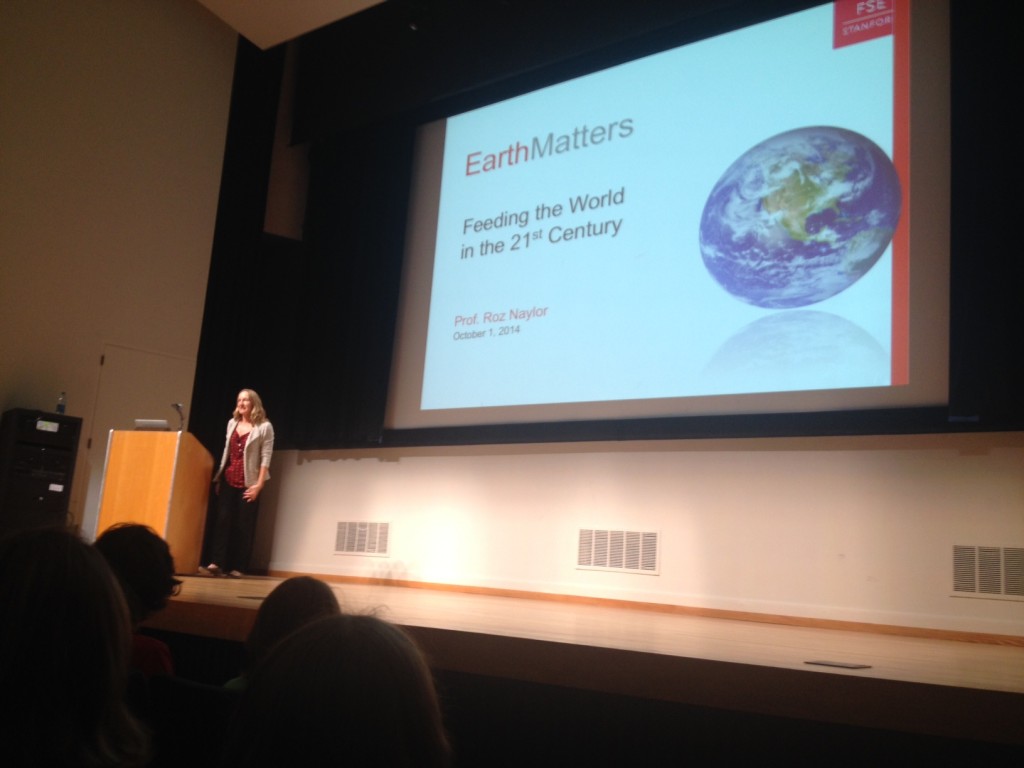Today, the world has a sufficient reserve of food to feed the global population of seven billion people. But if two major trends — climate change and population growth — continue the way experts think they will, that food supply may not last beyond the next couple of decades.
That’s the significant message the more than 100 students and community members who packed Stanford’s Cubberley Auditorium on Oct. 1 came away with. Already, Stanford Professor Rosamond Naylor told the crowd, more than one billion people around the world suffer from chronic hunger, mostly because of storage and transportation obstacles, or because they simply can’t afford to buy what is grown.

In a speech called “Earth Matters: Feeding the World in the 21st Century,” global food security expert Naylor warned that with an expected two billion more people on the planet by mid-century, and lower crop yields caused by climate change and extreme events such as the ongoing drought in California, the food supply might not outstrip food demand for much longer.
“I do get worried about climate,” Naylor said. “We are still having the discussion of does it exist. We know temperatures are going to go up. We need to get past that and start looking for future solutions.”
Scott Roycroft, senior earth systems major at Stanford, expressed his excitement about Naylor’s speech. “I’ve taken two classes with Professor Naylor,” he said after the speech, which introduced Naylor’s new book, “The Evolving Sphere of Food Security.” “I was really impressed by how she put it all together,” Roycroft said. “It seemed like she really left an impression on the audience.”
Marika Sitz, a senior studying human biology and earth systems, was also impressed by Naylor’s speech. Sitz is the co-director of The Stanford Food Project (SFP). The SFP is an undergraduate student-led group whose focus is to advance general awareness of sustainable food and farming at Stanford, and to advocate a sustainable and conscientious food system on Stanford’s campus.
The work Sitz and her team are doing is exactly the kind of initiative Naylor says is needed if we’re going to overcome hunger and malnourishment — even in affluent areas like Stanford.
“This quarter we are focusing our attention solely on putting together a resource guide for students,” Sitz said. “That’s going to be a published tangible thing that we can hand out to people hopefully by the beginning of winter quarter, and it is just going to be a guide to everything [related to] food and farming around Stanford’s campus.”

Roycroft, too, is being proactive in the fight against the drought and for food security. The senior earth systems major is trying to reduce his beef consumption, due to the tremendous amount of water it takes to produce beef. “It’s not just turning off the faucet when you’re brushing your teeth,” Roycroft said. “There are bigger issues at hand. Things like diets, what foods we eat and food waste. How we address our food security can have a great influence on the water issues and the lack of water currently in California.”
Naylor yearns for more people like Sitz and Roycroft to promote food and water sustainability, and to try out new ideas and possible solutions. Even for a community as prosperous as Stanford and its surrounding area, access to sufficient, nutritious food cannot be taken for granted.
According to Feeding America, a hunger-relief charity, Santa Clara County had a 12.6 percent Food Insecurity Rate for the year 2012. That means out of the 1.9 million residents of Santa Clara County, over 225,000 people lacked reliable access to a sufficient quantity of affordable, nutritious food.
Naylor spends much of her time and effort thinking about access to food in disadvantaged parts of the world. But she hasn’t forgotten about how the issue affects her own neighborhood. “It’s very concerning that we can have economic and technological progress and yet have so many challenges feeding our own.”
(Homepage wheat photo courtesy of Jon Bunting on Flickr via Creative Commons.
